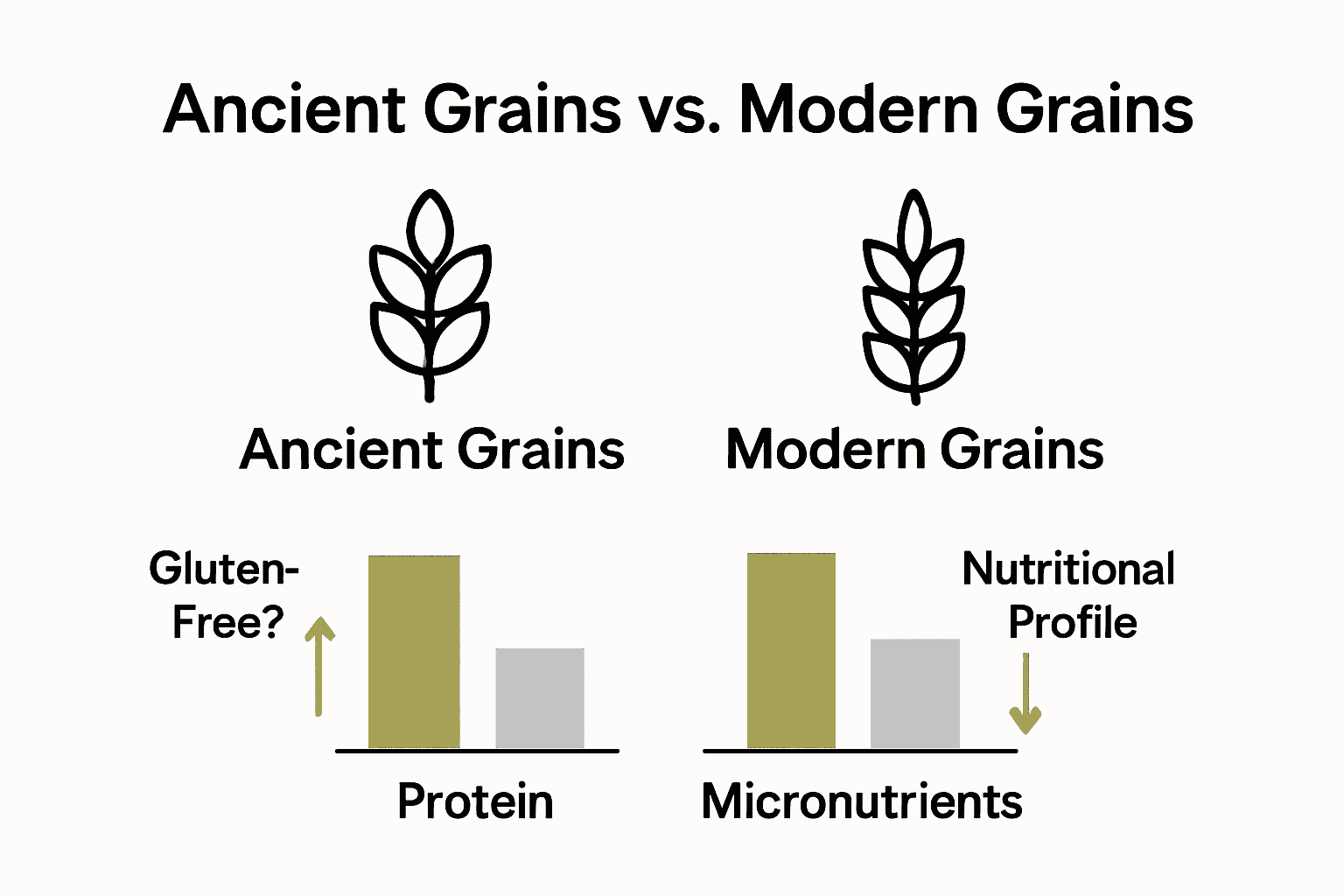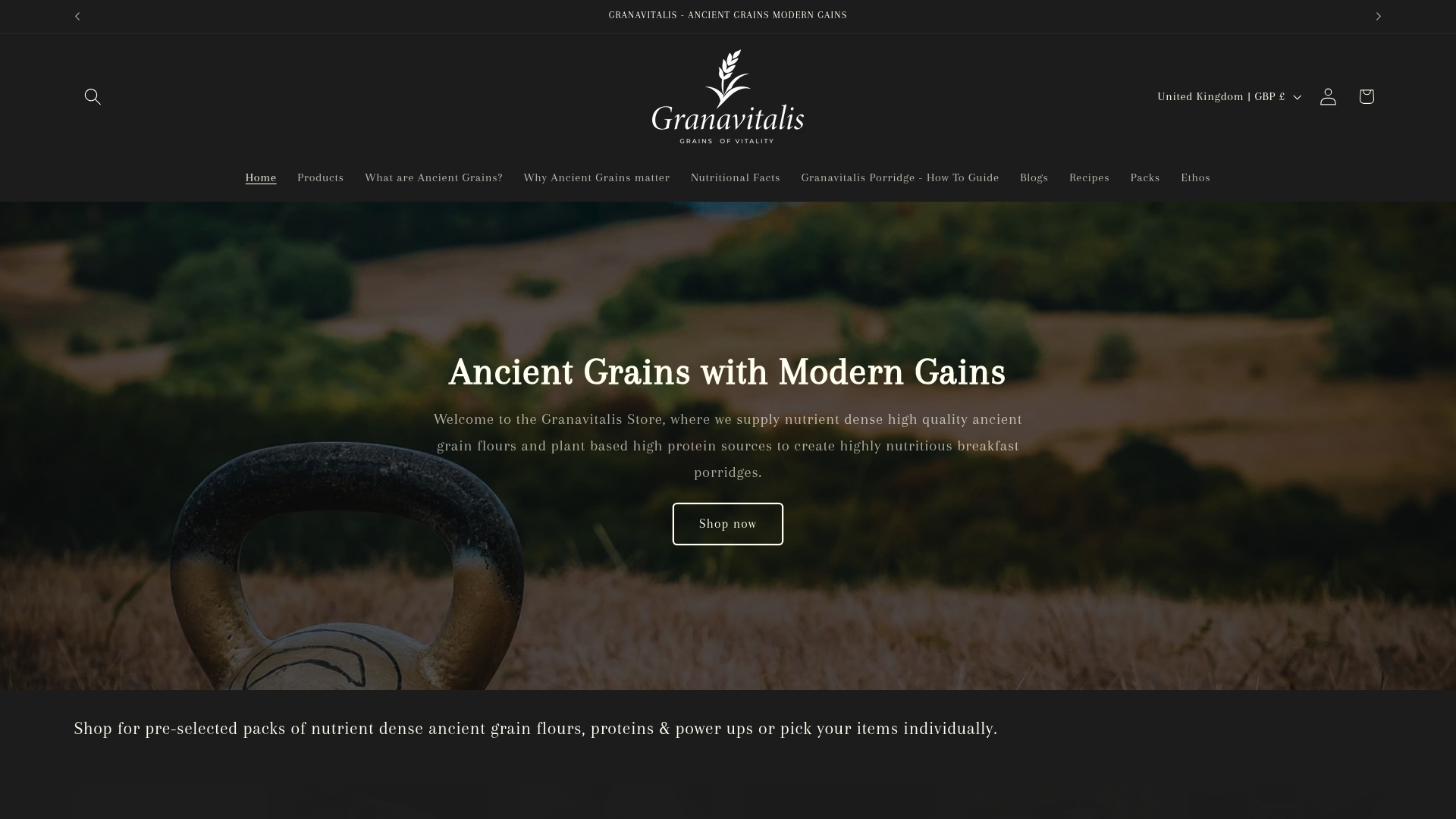
What Is Ancient Grain? Complete Guide for the UK
Share
More people are turning to ancient grains, yet confusion remains around what really sets them apart. These grains have stayed largely unchanged for hundreds of years, offering a direct link to our ancestors’ table. With names like einkorn, quinoa, and spelt gaining popularity, it’s easy to believe all ancient grains are healthier or gluten-free, but the reality is less simple. Understanding their unique history and nutritional value will help you make smart choices about including them in your meals.
Table of Contents
- Defining Ancient Grain And Common Misconceptions
- Types Of Ancient Grains And Key Differences
- Nutritional Benefits Of Ancient Grains
- Ancient Grains In Modern Diets
- Health Implications And Considerations
Key Takeaways
| Point | Details |
|---|---|
| Ancient Grains’ Definition | Ancient grains are those that have remained unchanged for centuries, such as einkorn and quinoa, connecting us to agricultural traditions. |
| Health Misconceptions | While often considered healthier, ancient grains are not universally superior; some modern whole grains offer similar benefits. |
| Nutritional Benefits | Ancient grains provide unique nutritional profiles, including complete proteins and high micronutrient content, making them a valuable addition to diets. |
| Gluten Sensitivity | Not all ancient grains are gluten-free; individuals with gluten sensitivity should select options like quinoa and avoid gluten-containing grains like spelt. |
Defining Ancient Grain and Common Misconceptions
Ancient grains represent a fascinating category of food that connects us with humanity’s agricultural heritage. According to the Whole Grains Council, these are grains that have remained largely unchanged over several hundred years, distinguishing them from modern wheat varieties that have undergone extensive breeding and modification.
The definition encompasses a diverse range of grains and pseudocereals, including traditional varieties like einkorn, emmer, spelt, and Kamut, as well as pseudocereals such as quinoa and amaranth. These grains represent more than just a nutritional choice - they are living historical artifacts that have sustained human populations for millennia, offering a direct connection to agricultural practices of our ancestors.
However, several common misconceptions surround ancient grains that require careful examination. One prevalent myth is that ancient grains are automatically healthier than modern grains. While they are indeed more nutritious than refined grains, Wheat Foods Council notes that common whole grains like brown rice and whole wheat bread can offer comparable health benefits. Another critical misunderstanding relates to gluten content: many people assume all ancient grains are gluten-free, but grains like spelt and Kamut actually contain gluten and are not suitable for individuals with celiac disease.
To truly appreciate ancient grains, it’s essential to understand their unique characteristics:
- Genetically closer to original wild grains
- Often higher in protein and micronutrients
- More diverse in flavor profiles
- Typically grown using more traditional agricultural methods
By exploring these remarkable grains, you’re not just selecting a food - you’re participating in a rich culinary tradition that spans thousands of years of human agricultural innovation.
Types of Ancient Grains and Key Differences
Exploring the world of ancient grains reveals a rich tapestry of nutritional diversity, with each variety offering unique characteristics and culinary potential. Scotland’s Rural College highlights several ancient grains particularly suitable for UK cultivation, including spelt, heritage wheat, einkorn, and emmer. These grains are not just historical curiosities, but living agricultural treasures with distinctive agronomic profiles.
Each ancient grain brings its own remarkable nutritional and flavor profile to the table. According to the Wheat Foods Council, these grains offer remarkable variations in taste and nutrition. Einkorn, for instance, boasts a higher protein content and exceptional nutritional value, while Kamut is renowned for its sweet, nutty flavor and elevated protein levels compared to modern wheat varieties.
The cultivation and characteristics of these ancient grains present fascinating differences. Some, like spelt and einkorn, are recommended for winter sowing, whereas emmer offers flexibility with both winter and spring planting options. Importantly, these grains often require specialized agricultural approaches - spelt, for example, needs specific machinery for dehulling due to its harder hull structure, setting it apart from conventional crop processing.

Key differences among ancient grains include:
Here’s a comparison of selected ancient grains and their key characteristics:
| Ancient Grain | Protein Content | Gluten-Free | Notable Nutrients / Features |
|---|---|---|---|
| Einkorn | High | No | Rich in carotenoids, iron |
| Spelt | Moderate | No | High fibre, magnesium |
| Kamut | High | No | More protein than modern wheat Omega-3s |
| Quinoa | High | Yes | Complete protein Magnesium, iron |
| Amaranth | High | Yes | Double protein of rice/corn Calcium |
| Millet | Moderate | Yes | Antioxidants, magnesium |
| Teff | Moderate | Yes | High iron, dietary fibre |
| Emmer | Moderate | No | B-vitamins, minerals |
| Sorghum | Moderate | Yes | B-vitamins, fibre |
- Protein content variations
- Unique flavor profiles

- Cultivation requirements
- Processing complexity
- Nutritional density
Learn more about the nuanced differences between ancient and modern cereals in our comprehensive guide on ancient grains vs modern cereals, where we dive deeper into the agricultural and nutritional distinctions that make these grains so extraordinary.
Nutritional Benefits of Ancient Grains
Ancient grains offer a nutritional powerhouse that goes far beyond conventional modern grains, providing an exceptional blend of nutrients that can transform your dietary approach. Brown University Health Services reveals fascinating insights into these nutritional superstars, highlighting how each grain brings unique benefits to our diet.
Take quinoa, for instance, which stands out as a complete protein containing all nine essential amino acids - a remarkable feat that makes it particularly valuable for vegetarians and vegans seeking protein-rich alternatives. Similarly, amaranth offers an impressive protein profile, delivering double the protein content found in traditional rice and corn. The Wheat Foods Council further expands on these nutritional wonders, noting that grains like millet are packed with antioxidants and magnesium, potentially helping prevent and manage complex health conditions such as high blood pressure, heart disease, and diabetes.
The nutritional diversity of ancient grains extends far beyond basic macronutrients.
Teff emerges as a nutritional champion, boasting high levels of dietary fiber and iron - crucial elements for supporting digestive health and preventing anaemia. Sorghum contributes its own nutritional magic, delivering essential B-vitamins, minerals, and fiber that collectively support overall well-being and metabolic function.
Key nutritional highlights of ancient grains include:
- Complete protein profiles
- High antioxidant content
- Rich mineral compositions
- Excellent dietary fiber sources
- Low glycemic index options
Discover more about how ancient grains naturally support wellness in our comprehensive guide, and unlock the potential of these extraordinary nutritional powerhouses.
Ancient Grains in Modern Diets
The renaissance of ancient grains in contemporary nutrition represents a fascinating intersection of traditional agricultural wisdom and modern dietary innovation. Scotland’s Rural College highlights the remarkable adaptability of these grains, demonstrating how they can be seamlessly integrated into current farming practices and food systems through standard arable rotation methods.
Modern culinary landscapes are increasingly embracing ancient grains, transforming them from historical curiosities into mainstream dietary staples. The Wheat Foods Council reveals exciting developments in product innovation, such as sorghum finding its way into gluten-free baking mixes, cereals, and breads, thanks to its mild flavor and impressive nutritional profile. Teff has similarly emerged as a versatile ingredient, now appearing in diverse products like tortillas, pizza bases, crackers, and pasta.
The integration of ancient grains into contemporary diets goes beyond mere novelty - it represents a strategic nutritional approach. These grains are particularly well-suited to low-input agricultural systems, making them an environmentally conscious choice for farmers and consumers alike. Their versatility allows them to be cultivated using standard agricultural machinery, bridging the gap between traditional grain varieties and modern farming techniques.
Key ways ancient grains are transforming modern diets:
- Gluten-free product development
- Nutritional diversity in mainstream foods
- Sustainable agricultural practices
- Expanded culinary creativity
- Enhanced nutritional profiles
Discover how to naturally incorporate these remarkable grains into your daily meals with our comprehensive guide, and revolutionize your approach to wholesome nutrition.
Health Implications and Considerations
Gluten sensitivity and dietary restrictions represent critical considerations when exploring ancient grains. Northumbria University’s research reveals a complex landscape of grain composition, challenging common assumptions about ancient wheat varieties and their potential health impacts.
The Wheat Foods Council provides crucial insights into the diversity of ancient grains, highlighting that not all are created equal from a dietary perspective. While quinoa and amaranth offer gluten-free options perfect for those with celiac disease, grains like spelt and Kamut contain gluten and remain unsuitable for individuals with gluten sensitivities. Remarkably, the research indicates that ancient wheats often contain higher protein levels and potentially more celiac disease-active epitopes compared to modern wheat varieties.
Navigating the health implications of ancient grains requires a nuanced, personalized approach. The research emphasizes that no single wheat type can be universally recommended for mitigating celiac disease risks. Instead, individuals must consult healthcare professionals and undergo proper medical diagnosis to understand their specific dietary needs and potential grain tolerances.
Key health considerations for ancient grains include:
- Individual gluten tolerance levels
- Protein and nutrient density variations
- Potential inflammatory responses
- Personal digestive sensitivities
- Comprehensive medical guidance
For a deeper understanding of gluten-free ancient grain options, explore our comprehensive guide and make informed decisions about your nutritional journey.
Rediscover the Power of Ancient Grains in Your Everyday Diet
If you are intrigued by the rich history and unique nutritional benefits of ancient grains but feel unsure how to bring them into your kitchen, Granavitalis has you covered. Many ancient grains offer superior protein content and valuable micronutrients however, they can sometimes be hard to find or incorporate into familiar recipes. Whether you are looking for gluten-free options or nutrient-dense flours to fuel your body with lasting energy, our carefully selected range meets these needs with ease.

Explore our premium selection of All Flours to access authentic ancient grain flours that respect tradition and nourish your body. For those managing gluten sensitivities, our Gluten Free Flours bring the wholesome benefits of ancient grains without compromise. Elevate your meals further with Protein Power Packs designed to support muscle repair and steady energy throughout the day. Visit Granavitalis today and take the first step towards embracing ancestral nourishment that energises your mornings and supports well-being for the long term.
Frequently Asked Questions
What are ancient grains?
Ancient grains are grains that have remained largely unchanged over several hundred years, including varieties like einkorn, emmer, spelt, and Kamut, as well as pseudocereals such as quinoa and amaranth.
Are ancient grains healthier than modern grains?
While ancient grains often offer more nutrients than refined grains, many common whole grains, such as brown rice and whole wheat, can provide comparable health benefits. It’s essential to consider overall dietary balance rather than focusing solely on the grain type.
Do all ancient grains contain gluten?
No, not all ancient grains are gluten-free. While pseudocereals like quinoa and amaranth are gluten-free, grains such as spelt and Kamut contain gluten and are not suitable for individuals with celiac disease or gluten sensitivities.
How can ancient grains be included in modern diets?
Ancient grains can be easily integrated into modern diets through various culinary applications. They can be used in gluten-free baking, included in salads, or substituted in traditional dishes, enhancing both nutrition and flavor.
